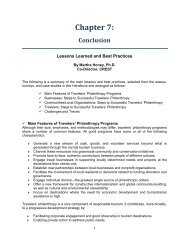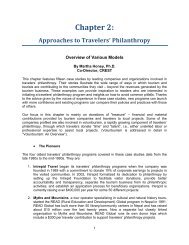Travelers' Philanthropy Handbook - Center for Responsible Travel
Travelers' Philanthropy Handbook - Center for Responsible Travel
Travelers' Philanthropy Handbook - Center for Responsible Travel
You also want an ePaper? Increase the reach of your titles
YUMPU automatically turns print PDFs into web optimized ePapers that Google loves.
their part simply by choosing to travel with you, and that the opportunity exists to make a morepersonal statement (in the <strong>for</strong>m of a contribution) if they so desire.In Galapagos, <strong>for</strong> example, guides do not make a <strong>for</strong>mal request <strong>for</strong> guests to consider donatingto the Galapagos Conservation Fund. The Galapagos Conservation Fund (GCF or the Fund)was started by Lindblad Expeditions in 1997 so guests couldcontribute directly to local conservation projects thatpreserve the islands <strong>for</strong> generations to come. Fundscontributed by Lindblad guests are directed entirely to localprojects across the islands, as determined by anindependent board and implemented by the GalapagosNational Park and Charles Darwin Research Station. Duringits first decade, the GCF raised more than $4.5 milliondollars that have been used in a variety of local projectssuch as the eradication of feral pigs from the island ofSantiago and the support of National Park Marine Reservepatrol boats. Today, the fund is called the LindbladExpeditions/National Geographic Fund <strong>for</strong> Galapagos and isGuide in the Galapagos.Credit: Sam Hamadministered by the National Geographic Foundation in collaboration with Galapagos NationalPark and Charles Darwin Research Station. (Seewww.expeditions.com/<strong>Travel</strong>_<strong>Philanthropy</strong>502.asp).The Fund is mentioned occasionally by the guides, and sometimes guests ask questions aboutit (due to their reading about the Fund on the company website or learning about it from anotherguest), but the <strong>for</strong>mal offer to participate in the program is presented privately to guests in the<strong>for</strong>m of the brochure that is placed in their cabins two days be<strong>for</strong>e they disembark. While thestrategic messages targeting guests’ beliefs about donating are generously integrated into theoverall interpretive program during the 7-day expedition, they are rightly focused on interpretingGalapagos (i.e., wildlife, ecology, and history of the islands) and the many threats faced by thearchipelago. But mention of the Fund, itself is kept subtle and does not intrude into theexperience Lindblad’s guests pay to enjoy. In other words, Lindblad’s strategy is first to facilitatea bond between its guests and Galapagos, and then to offer the guests an opportunity to act inbehalf of a place they care about.• ConclusionIn summary, what might seem like an “ask” is really an “offer” if you have adequately preparedyour travelers with an outstanding experience ─ one that leads them to know about a place, andalso leads them to care about it. We should not underestimate the importance of this chain ofevents. As one of the primary messages in Lindblad’s Galapagos and Baja Cali<strong>for</strong>niaphilanthropy campaign materials states:Ultimately, the governments of the world will be unable by themselves to save the trulyspecial places. It will be the passion and insistence of travelers that will help make thishappen.I hope these guidelines serve to move your philanthropy campaign a step closer to that loftygoal.149















